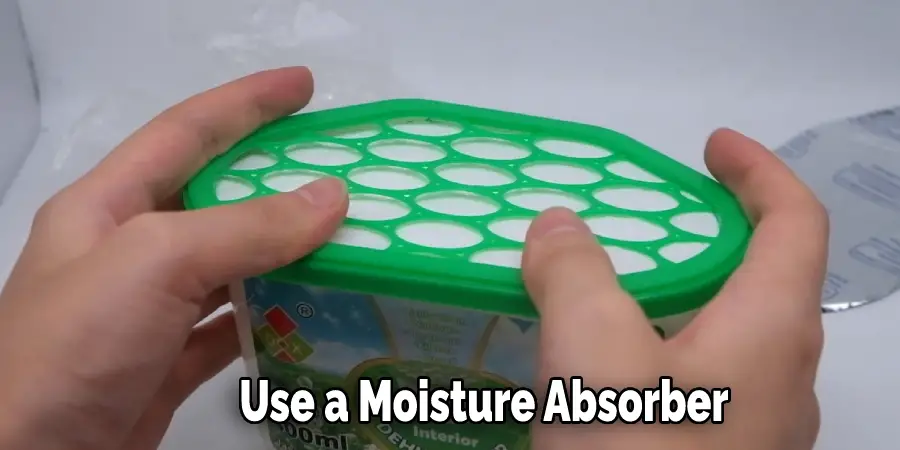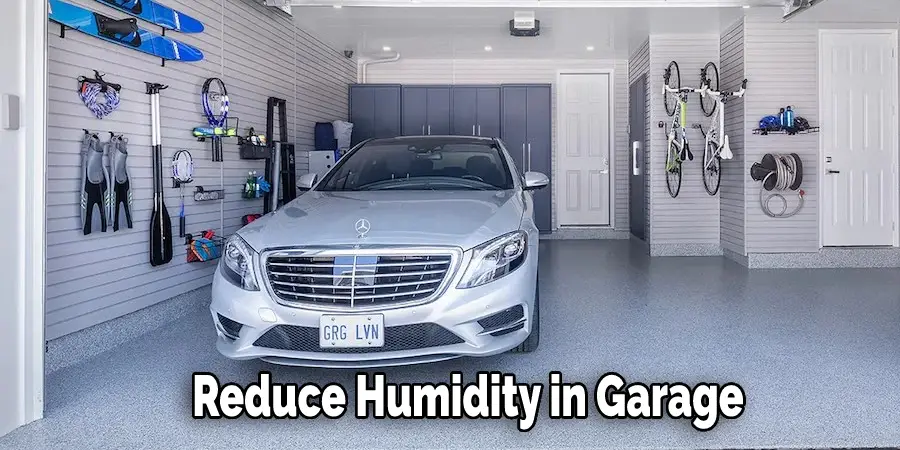Garages are notorious for being high in humidity, leading to many problems. In this post, we’re going to show you how to reduce humidity in garage quickly and easily. Keep reading to learn more!

Summary: Reducing humidity in a garage can be achieved through various methods, such as installing a dehumidifier, improving ventilation, fixing leaks or cracks, using moisture-absorbent materials, and keeping the garage clean and dry. These steps can help prevent moisture buildup, damaging tools, equipment, and stored items, and improve the air quality in the garage.
Why It’s Important to Reduce Humidity in Garage?
Many homeowners are unaware of the importance of reducing humidity in their garage. High humidity levels can cause a variety of problems, including mold and mildew growth, wood rot, and musty odors.
In addition, high humidity levels can make it difficult to keep your garage clean and organized. Dust and dirt will stick to surfaces more easily, and it will be harder to prevent mold and mildew from taking hold. Fortunately, there are a few simple steps to reduce the humidity in your garage.
How to Reduce Humidity in Garage Step by Step Guide
Step 1: Assess the Humidity Level
Before taking action to reduce humidity in your garage, assess the current humidity level using a hygrometer. A hygrometer is a device that measures the moisture content in the air. Knowing the humidity level will help you understand the severity of the problem and determine which solutions are most appropriate.
Step 2: Improve Ventilation
Improving the airflow in your garage can significantly reduce humidity. Some ways to improve ventilation include:
- Installing exhaust fans or vents to expel moist air and draw in fresh, drier air.
- Keeping the garage door and windows open during the day to allow air circulation.
- Using box fans or oscillating fans to circulate air inside the garage.
Step 3: Seal Gaps and Cracks
Moisture can enter your garage through gaps and cracks in walls, doors, and windows. Inspect your garage for any openings and seal them using weatherstripping, caulk, or expandable foam. Pay special attention to the garage door’s edges and the areas around windows.
Step 4: Insulate Your Garage
Proper insulation can help regulate the temperature inside your garage and reduce humidity. Insulate walls, ceilings, and garage doors using appropriate insulation materials such as fiberglass batts, foam boards, or spray foam. If you’re unsure about how to insulate your garage correctly, consult a professional.
Step 5: Install a Vapor Barrier
A vapor barrier is a material that prevents moisture from passing through walls, ceilings, and floors. Installing a vapor barrier in your garage can help reduce humidity by preventing moisture from entering the space. Common vapor barrier materials include polyethylene plastic sheeting or specialized paint coatings.
Step 6: Use a Dehumidifier
A dehumidifier is a device that removes excess moisture from the air. Place a dehumidifier in your garage to help reduce humidity, especially in areas prone to dampness or where moisture accumulates. Make sure to empty the dehumidifier’s water reservoir regularly and maintain the unit according to the manufacturer’s instructions.
Step 7: Maintain Gutters and Downspouts
Clogged gutters and downspouts can cause water to accumulate around the foundation of your garage, leading to increased humidity. Regularly clean and maintain your gutters and downspouts to ensure proper water drainage away from your garage. Installing gutter guards can help prevent clogs and reduce maintenance.
Step 8: Address Water Leaks and Damage
Inspect your garage for signs of water leaks or damage, such as water stains, mold, or mildew. Address any leaks by repairing or replacing damaged pipes, fixtures, or roofing materials. If you find mold or mildew, clean the affected area with a solution of water and bleach, and take steps to prevent future growth.
Step 9: Store Items Properly
Storing items off the floor and using shelving units can help reduce humidity by promoting air circulation and preventing moisture from becoming trapped. Keep items in plastic bins with tight-fitting lids to protect them from moisture damage. Avoid storing wet or damp items in the garage, and promptly dry any spills or moisture accumulation.
Step 10: Use Moisture-Absorbing Products
Place moisture-absorbing products, such as desiccant packs or silica gel, in areas prone to dampness or moisture accumulation. These products can help reduce humidity by absorbing excess moisture from the air. Replace or recharge the moisture-absorbing products as needed, following the manufacturer’s recommendations.
Step 11: Install a Moisture-Resistant Floor
Moisture-resistant flooring, such as epoxy or polyaspartic coatings, can help reduce humidity in your garage by preventing moisture from seeping through the floor. These coatings also provide a durable and easy -to-clean surface, making them a practical choice for garage floors. Consult a professional for installation, as proper preparation and application are crucial for effective results.
Step 12: Promote Airflow with Plants
Adding plants to your garage can help reduce humidity, as they naturally absorb moisture from the air through a process called transpiration. Choose plants that thrive in low-light and high-humidity environments, such as ferns, snake plants, or pothos. Place the plants near windows or other areas where they can receive natural light, and be sure to care for them according to their specific needs.
Step 13: Install an Air Conditioning Unit
Installing an air conditioning unit in your garage can help to regulate temperature and reduce humidity. Choose a suitable unit based on the size and layout of your garage and consult a professional for proper installation. When using an air conditioner, ensure that it is set to a comfortable temperature, and regularly maintain the unit according to the manufacturer’s instructions.
Step 14: Periodically Monitor Humidity Levels
To ensure that your efforts to reduce humidity are effective, periodically monitor the humidity levels in your garage using a hygrometer. If you notice a spike in humidity, revisit the previous steps to identify and address the cause.
Step 15: Develop a Routine Maintenance Plan
Establish a routine maintenance plan to keep your garage’s humidity levels in check. This plan should include regular inspections for water leaks and damage, gutter and downspout maintenance, dehumidifier upkeep, and other tasks related to humidity control. By staying proactive, you can prevent future humidity issues in your garage.
By following these steps, you can effectively reduce humidity in your garage, creating a more comfortable and functional space. It is crucial to address humidity issues promptly, as excessive moisture can lead to mold and mildew growth, damage stored items, and affect your garage’s overall structural integrity. Regular maintenance and a proactive approach to humidity control can help you maintain a dry, healthy garage environment.
Causes of Humidity in The Garage
The garage is one of the most important places in the home. It is where we store our cars, tools, and other belongings. Unfortunately, however, the garage can also be one of the most humid places. This is because it is often located near the laundry room or kitchen, two of the most common sources of humidity.
There are a few things that can cause humidity in the garage:
The Weather:
Hot and humid weather can cause the garage to become humid. This is because the warm air will rise and condense on the cold surfaces in the garage, such as the walls and floor.
The Garage Door:
The garage door is the biggest source of humidity in the garage. When the door is open, warm, moist air is allowed to enter the garage. This can cause condensation on the walls and floors.
The Vehicles:
Cars, trucks, and other vehicles produce water vapor when they run. This vapor can condense on the walls and ceiling of the garage, causing humidity.
Leaks:
One of the most common causes of humidity in the garage is leaks. Leaks can come from several places, such as the roof, walls, or doors. If there is a leak in the garage, it can allow moisture to seep in and cause the air to become more humid.
Poor Ventilation:
Another common cause of humidity in the garage is poor ventilation. If the garage does not have enough vents, the air will become stagnant and humid.

The Location:
The garage is often located near the laundry room or kitchen, two of the most common sources of humidity. In addition, many garages are not well-ventilated, which can compound the problem.
Humidity and Its Effects on The Garage
Many people don’t think twice about the humidity levels in their garage. However, the truth is that humidity can have a big impact on this space. For example, high humidity levels can cause corrosion of metals, warping of wood, and mold growth.
Additionally, humid air can make it difficult to keep tools and other items dry in the garage. As a result, it’s important to control the humidity in your garage. Keep reading for more information about how to reduce humidity in garage.
The Benefits of Reducing Humidity in The Garage
Many homeowners do not give much thought to the humidity levels in their garage. However, reducing the amount of moisture in the air can have several benefits. For one, it can help to prevent rust and corrosion on tools and other metal surfaces.
In addition, it can discourage the growth of mold and mildew, which can cause health problems for both people and animals. Finally, lower humidity levels can make the garage more comfortable, especially during hot summer months.
There are a few different ways to reduce the humidity in a garage, such as using a dehumidifier or opening vents to allow air to circulate. Taking these simple steps can help to keep both your garage and your belongings in good condition.
What Can You Use to Reduce Humidity in Garage?
Many garages are humid, and this can be a problem because it can lead to the growth of mold and mildew. In addition, high humidity levels can make it difficult to work in the garage because of the dampness.
There are a few things you can do to reduce the humidity in your garage. One option is to use a dehumidifier. This will help to remove the moisture from the air, and it will also help improve the air quality in the garage.

Another option is to use fans to circulate the air and help to dry out the garage. Finally, you can also try opening the garage door when it is not used to allow air to circulate and reduce the humidity levels.
By taking these steps, you can help to reduce the humidity in your garage and make it a more pleasant place to work.
Frequently Asked Question
How Much Does It Cost to Hire a Professional?
It can cost anywhere from $50 to $200 to hire a professional to help reduce humidity in your garage. However, you can do a few things yourself to help decrease the amount of moisture in the air.
What Is the Best Way to Reduce Humidity in Garage?
There are a few different ways to reduce humidity in your garage. One way is to use a dehumidifier. Another way is to open the door to your house when the weather is dry outside and close it when it is humid. You can also use a fan to circulate the air in your garage.
Conclusion
Thanks for following our guide on how to reduce humidity in garage. We hope that you have found it helpful and easy to follow. If you have any questions or suggestions, please leave us a comment below!
